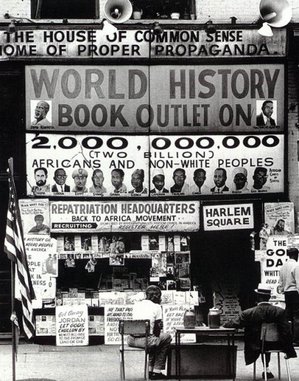The Book
From Head Shops to Whole Foods: The Rise and Fall of Activist Entrepreneurs
The Author(s)
Joshua Clark Davis

Review by Robert J. Greene II, book review editor.
Joshua Clark Davis has performed an admirable and necessary service in his new book, From Head Shops to Whole Foods. Here, he has written about one of the most important legacies of activism in the 1960s: the combination of activist politics with the entrepreneurial spirit. However, most of the subjects in Davis’ book did not see themselves as participating in capitalism. On the contrary—most of the founders of African American owned bookstores, feminist credit unions, head shops, and natural food groceries were all, to varying degrees, using their businesses for distinctly non-capitalist goals. Not interested in profit, these small business owners were often trying to use their stores as places of intellectual ferment and “free spaces,” away from mainstream observation or condemnation.

Outside of Lewis Michaux’s bookstore in Harlem.
Davis argues that these businesses were important for several reasons. Among those were the need to “introduce products that promoted progressive and radical politics as well as cultural pluralism in the marketplace” (4). Think of the rise of African American bookstores in the late 1960s and early 1970s, as a chief example. Their rise coincided with the high tide of Black Power and the Black Arts Movement. Some of the bookstore owners, such as Edward Vaughn of Detroit or Lewis Michaux in Harlem, became prominent figures of the Black Power Movement. These bookstores became places where radical African Americans could discuss the latest trends in Third Worldism, pan-Africanism, and Marxist-Leninist debates. For most bookstore owners, the point of the stores wasn’t to make money. They were to educate a new generation of African Americans in collective struggle. As Davis puts it, “Nevertheless, Black Power and black bookselling were becoming increasingly intertwined” (52).
Also, these businesses written about by Davis provided an alternative to the capitalism of 1960s America. Feminist credit unions and feminist-based businesses were designed to circumvent both capitalist exploitation and gender discrimination in American society. However, as Davis points out, not all feminists were on board with these businesses—with some even referring to them as “cultural feminism,” or an attempt to substitute a weaker, market-friendly feminism for more radical offerings (162-163). Indeed, one of the strengths of Davis’ book is the extent to which he shows how each group represented here—African Americans, feminists, pro-drug legalization activists behind most “head shops,” and environmentalists who supported natural food stores—all wrestled with internal debates about the import ance of these stores to their overall cause.
ance of these stores to their overall cause.
Ultimately, From Head Shops to Whole Foods deserves to be thought of as an intellectual history because of how Davis considers both ideology and physical space. Ideology matters—as mentioned above, these stores were being created with radical ends in mind. But they also provided a place for people to think about what their ideologies meant to them. African Americans could congregate in a black-owned bookstore and feel free to talk about the struggles of everyday life, while connecting them to larger ideals propounded by the authors of the books they’re perusing. Visitors to a natural food store were confident that they were meeting other people who were also concerned about the environment and the quality of the food they were putting into their bodies. With the term “marketplace of ideas” being used so much these days, Davis’ book offers a chance to reverse that phrase—to think of “ideas of a marketplace” and understand that their meaning can change depending on whose creating, and owning, said marketplace.
Marketplace also matters in how most of these shops came to an end. By the late 1970s, openly activist stores fell out of favor with most Americans. In addition, a struggling economy made it harder to keep any small business open, much less those that were never overly concerned with making money. Other ideological and technological trends explain how some of these stores disappear—the fall of Black Power by the late 1970s, or the setbacks to the second-wave feminist movement before and after the failure of the passage of the Equal Rights Amendment in the early 1980s. But above all, it was larger businesses taking notice of these smaller stores, and their clientele, that doomed them. Barnes and Noble began presenting more books by African American authors (although not many as radical as those on offer at places such as Drum and Spear in Washington, D.C.), while other companies catered towards women with a “feminist” bent. And then there’s the biggest example of all: Whole Foods, a company born of the natural food movement of the 1960s and 1970s now becoming one of the most recognizable grocery chains in the country. Its recent acquisition by Amazon occurred right as the book was being released, but it’s safe to say that Whole Foods emerges as the most powerful survivor of the collapse of most of these stores. Ironically, Whole Foods’ owner John Mackey, a libertarian with many ideological views anathema to most of the other store owners profiled in the book, survived and thrived by selling Whole Foods to activists and like-minded people—without any of the actual activism attached.
From Head Shops to Whole Foods is a critical read for American historians and intellectual historians. I can see it being assigned for many graduate level courses on 20th century American intellectual, economic, cultural, and social histories. I’d go so far as to say it could also be useful for a senior seminar here or there as well. I also admit to having a personal tie to the book’s story. As I’ve written before, growing up in Georgia my father took me to a black-owned bookstore. As it was part of what Davis refers to as a brief revitalization of the black bookstore—coupled with the return of black nationalism in the late 1980s and early 1990s—I think, in some ways, I have a personal connection to the central story Davis tells here. That bookstore was my first exposure to most African American authors I may otherwise have never heard of until college. So it was for my predecessors in the 1960s and 1970s. With accessible prose, considerable research in various archives, and an intriguing analysis of the combination of capitalism and radicalism, From Head Shops to Whole Foods is a must-read for many of our readers at S-USIH.

2 Thoughts on this Post
S-USIH Comment Policy
We ask that those who participate in the discussions generated in the Comments section do so with the same decorum as they would in any other academic setting or context. Since the USIH bloggers write under our real names, we would prefer that our commenters also identify themselves by their real name. As our primary goal is to stimulate and engage in fruitful and productive discussion, ad hominem attacks (personal or professional), unnecessary insults, and/or mean-spiritedness have no place in the USIH Blog’s Comments section. Therefore, we reserve the right to remove any comments that contain any of the above and/or are not intended to further the discussion of the topic of the post. We welcome suggestions for corrections to any of our posts. As the official blog of the Society of US Intellectual History, we hope to foster a diverse community of scholars and readers who engage with one another in discussions of US intellectual history, broadly understood.
Many of us in Texas have long known John Mackey’s personal beliefs. Much of the rest of “activist nation” got a wake-up call when he opposed Obamacare. Texas Monthly recently had a long profile of his history: https://features.texasmonthly.com/editorial/shelf-life-john-mackey/
Thanks, Robert. A few questions: Is there a tone to this book, i.e declensionist, optimistic, neutral? As in, without ostensibly pursuing a profit motive these ideologically driven enterprises are doomed to failure. Or, this was a furtive period of imaginative activism that was co-opted by more capital driven corporations etc? A success of capitalism or a failure of radicalism? Would you or the author put Black Entertainment Television (BET) in this same narrative vein?